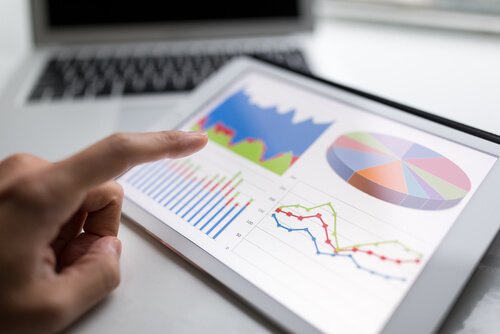Basic Statistics Concepts

Statistics is a branch of mathematics that studies variability as well as the process that calculates it by following the laws of probability and using its models. We know that statistics are necessary to carry out investigations as well as to understand them. But what are the basic statistics concepts?
To focus on the basic statistics concepts, we must turn to descriptive statistics. This branch deals with the description of the experimental data. Specifically, it encompasses the collection, organization, and analysis of data. The data describes a set of characteristics of a set of items that belong to a population.

According to Professor Ignacio Cascos of Charles III University of Madrid, these are some of the basic statistics concepts everybody should know:
1. Population
A population is a well-defined set of similar items with certain characteristics that are of interest to the observers.
This aspect can be finite or infinite. Therefore, the size of the population is the number of items it contains. It’s usually denoted by N.
If the population is very large, it can be very expensive to carry out the investigation. So, in some cases, it’s impossible to consider each element. Therefore, researchers usually select a few elements from the population or a sample.
2. Items
An item is an individual element of the population. Now, these elements don’t necessarily have to be people. However, in psychology, that’s usually the case.
3. Sample size
A sample is a set of items of the population that reflects its characteristics as best as possible. If the sample size reflects the characteristics of the population, then the sample is representative. Furthermore, the sample size is the number of items it has. We denote sample size n.
If the sample and population size coincide, then it’s a census.
4. Variables
A variable (X) is a symbol that represents any characteristic, number, or quantity of the population that researchers can measure or count. Data (r) is the value that can change within a variable (hence the name). Its value depends on the item it’s measuring.

Types of Variables
Qualitative Variable
This type of variable takes on values that correspond to nonquantifiable qualities of the items. Therefore, you can’t say one is worth more than the other.
An example of this type of variable could be gender. These variables are called qualitative because the differences between them are the qualities or characteristics.
Ordinal Variable
An ordinal variable can be divided into categories. Additionally, the researchers can rank or order them due to their value. If you were to have qualitative variables, you could rank them.
For example, think about school grades. An ‘A’ is better than a ‘B’. Likewise, a ‘B’ is better than an ‘F’.
Quantitative Variables
Quantitative variables take on numerical values. Thus, this means you can measure them in numbers. There are two types:
- Discrete variable. The set is finite or countable. For example, the number of children in a family.
- Continuous variable. The set is infinite or uncountable. For example, time.
Measures of Position
In descriptive statistics, you can determine the position of your data by using measures of position.
Measures of Central Tendency
Averages or measures of central tendency are typical or representative values of a data set. Therefore, their purpose is to summarize all the data with a single value.
The most common measures of central tendency are mode (qualitative variables), median (categorical variables), and mean (quantitative variables).

- Mode. The mode is the item that appears the most times. If there are more than one of these values, the variable is multimodal. Furthermore, you can calculate the mode for any type of variable.
- Median. You calculate it for categorical variables. In particular, at least half of the data is less than or equal to the median. Likewise, at least half of the data is also greater than or equal to the median. Therefore, if there’s more than one median, you must take the midpoint between the largest and smallest median. This will be the value that appears in the sample and serves as the median.
- Mean. It’s the most common or famous one. You may also know it as average. Specifically, you need to have quantitative variables in order to calculate it. The mean is the geometric center or where the data tends to. Something peculiar happens with the mean, as it may not be representative of the sample, but it may also not really represent any actual value from the sample. In other words, that value may not exist in the sample.
Final Thoughts
Although many more concepts are used in statistics, these are perhaps the most basic ones. With their help, you can organize and calculate statistics as well as data representations. Thus, these are great tools for researchers and the scientific community. Statistics give you a complete map of the results of an investigation.
Statistics is a branch of mathematics that studies variability as well as the process that calculates it by following the laws of probability and using its models. We know that statistics are necessary to carry out investigations as well as to understand them. But what are the basic statistics concepts?
To focus on the basic statistics concepts, we must turn to descriptive statistics. This branch deals with the description of the experimental data. Specifically, it encompasses the collection, organization, and analysis of data. The data describes a set of characteristics of a set of items that belong to a population.

According to Professor Ignacio Cascos of Charles III University of Madrid, these are some of the basic statistics concepts everybody should know:
1. Population
A population is a well-defined set of similar items with certain characteristics that are of interest to the observers.
This aspect can be finite or infinite. Therefore, the size of the population is the number of items it contains. It’s usually denoted by N.
If the population is very large, it can be very expensive to carry out the investigation. So, in some cases, it’s impossible to consider each element. Therefore, researchers usually select a few elements from the population or a sample.
2. Items
An item is an individual element of the population. Now, these elements don’t necessarily have to be people. However, in psychology, that’s usually the case.
3. Sample size
A sample is a set of items of the population that reflects its characteristics as best as possible. If the sample size reflects the characteristics of the population, then the sample is representative. Furthermore, the sample size is the number of items it has. We denote sample size n.
If the sample and population size coincide, then it’s a census.
4. Variables
A variable (X) is a symbol that represents any characteristic, number, or quantity of the population that researchers can measure or count. Data (r) is the value that can change within a variable (hence the name). Its value depends on the item it’s measuring.

Types of Variables
Qualitative Variable
This type of variable takes on values that correspond to nonquantifiable qualities of the items. Therefore, you can’t say one is worth more than the other.
An example of this type of variable could be gender. These variables are called qualitative because the differences between them are the qualities or characteristics.
Ordinal Variable
An ordinal variable can be divided into categories. Additionally, the researchers can rank or order them due to their value. If you were to have qualitative variables, you could rank them.
For example, think about school grades. An ‘A’ is better than a ‘B’. Likewise, a ‘B’ is better than an ‘F’.
Quantitative Variables
Quantitative variables take on numerical values. Thus, this means you can measure them in numbers. There are two types:
- Discrete variable. The set is finite or countable. For example, the number of children in a family.
- Continuous variable. The set is infinite or uncountable. For example, time.
Measures of Position
In descriptive statistics, you can determine the position of your data by using measures of position.
Measures of Central Tendency
Averages or measures of central tendency are typical or representative values of a data set. Therefore, their purpose is to summarize all the data with a single value.
The most common measures of central tendency are mode (qualitative variables), median (categorical variables), and mean (quantitative variables).

- Mode. The mode is the item that appears the most times. If there are more than one of these values, the variable is multimodal. Furthermore, you can calculate the mode for any type of variable.
- Median. You calculate it for categorical variables. In particular, at least half of the data is less than or equal to the median. Likewise, at least half of the data is also greater than or equal to the median. Therefore, if there’s more than one median, you must take the midpoint between the largest and smallest median. This will be the value that appears in the sample and serves as the median.
- Mean. It’s the most common or famous one. You may also know it as average. Specifically, you need to have quantitative variables in order to calculate it. The mean is the geometric center or where the data tends to. Something peculiar happens with the mean, as it may not be representative of the sample, but it may also not really represent any actual value from the sample. In other words, that value may not exist in the sample.
Final Thoughts
Although many more concepts are used in statistics, these are perhaps the most basic ones. With their help, you can organize and calculate statistics as well as data representations. Thus, these are great tools for researchers and the scientific community. Statistics give you a complete map of the results of an investigation.
All cited sources were thoroughly reviewed by our team to ensure their quality, reliability, currency, and validity. The bibliography of this article was considered reliable and of academic or scientific accuracy.
- de Datos, A. E. (1983). Estadística Descriptiva.
- Fernández, S. F., Sánchez, J. M. C., Córdoba, A., Cordero, J. M., & Largo, A. C. (2002). Estadística descriptiva. Esic Editorial.
-
García Pérez, A. (2008). Estadística aplicada: Conceptos básicos.
This text is provided for informational purposes only and does not replace consultation with a professional. If in doubt, consult your specialist.







